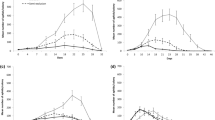Abstract
Cereal aphids on a wheat crop were sampled through the winter of 1982/1983 using both fixed and random quadrats.Sitobion avenae overwintered successfully anholocyclically although there was a substantial decline in the population of this species. No evidence for successful anholocyclic overwintering in other aphid species was found, althoughRhopalosiphum padi was seen to colonise the crop in early winter and was found until the end of December.
Eggs ofR. padi onPrunus padus were observed through the winter. A steady decline in their numbers occurred. The overall survival rate of the 5385 eggs was c.30%.
Eggs ofMetopolophium dirhodum onRosa spp. were also monitored. They also showed a steady decline in numbers through the winter. The overall survival rate of the 1360 eggs was c.34%.
Egg hatch in bothR. padi andM. dirhodum was closely synchronised with bud burst of their host plant. For the latter species this resulted in egg hatch starting in January.
Samenvatting
In de winter van 1982/1983 werden de graanluizen in een tarwegewas regelmatig geteld in willekeurig en in van tevoren gekozen monstereenheden. Hoewel er een aanmerkelijke afname van de populatie vanSitobion avenae werd waargenomen, overwinterde deze soort toch anholocyclish. Er werden geen aanwijzingen gevonden dat de andere bladluissoorten anholocyclish overwinterden hoewel kolonies vanRhopalosiphum padi tot eind december werden waargenomen.
De gehele winter werden eieren vanR. padi opPrunus padi aangetroffen, de aantallen ervan namen geleidelijk af; van de 5385 getelde eieren overleefde ongeveer 30%. Ook de aantallen eieren vanMetopolophium dirhodum opRosa spp. werden reglematig vastgesteld; ook hier werd een geleidelijke afname geconstateerd. Van de oorspronkelijk getelde 1360 eieren overleefde ongeveer 34%.
Het uitkomen van de eieren vanR. padi enM. dirhodum viel nauw samen met het uitlopen van de knoppen van hun waardplant. VoorM. dirhodum betekende dit dat de eerste eieren al begin januari uitkwamen.
Similar content being viewed by others
References
Dixon, A.F.G., 1971. The life cycle and host preferences of the bird cherry-oat aphid,Rhopalosiphum padi L., and their bearing on the theories of host alternation in aphids. Ann. appl. Biol. 68: 135–147.
Dixon, A.F.G., 1973. Biology of aphids; Institute of Biology studies in biology series, No. 44. Edward Arnold, London. 58pp.
Dixon, A.F.G., 1976. Timing of egg hatch and viability of the sycamore aphid,Drepanosiphum platanoides (Schr.) at bud burst of sycamore,Acer pseudoplatanus L. J. Anim. Ecol. 45: 593–603.
George, K.S., 1974. Damage assessment aspects of cereal aphid attack in autumn-and springsown cereals. Ann. appl. Biol. 77: 67–74.
Hand, S.C., 1982. Overwintering and dispersal of cereals aphids. Ph.D. thesis (unpub.), Southampton University.
Hand, S.C., 1983. The effect of temperature and humidity on the duration of development and hatching success of the aphid,Sitobion avenae. Ent. exp. appl. 33: 220–222.
Hand, S.C. & Williams, C.T., 1981. The overwintering of the rose-grain aphid (Metopolophium dirhodum on wild roses. In Thresh, J.M. (Ed) Pests, pathogens and vegetation, Pitman, London, pp. 307–314.
Hand, S.C. & Wratten, S.D., 1985. Production of sexual morphs by the monoecious cereal aphidSitobion avenae. Ent. exp. appl. 38: 239–247.
Hille Ris Lambers, D., 1947. Contributions to a monograph of the Aphididae of Europe. II. Temminckia 4: 1–34.
Hille Ris Lambers, D., 1947. Contributions to a monograph of the Aphididae of Europe. III. Temminckia 7: 179–319.
Leather, S.R., 1980. Egg survival in the bird-cherry oat aphid,Rhopalosiphum padi. Ent. exp. appl. 27: 96–97.
Leather, S.R., 1981. Factors affecting egg survival in the bird cherry-oat aphid,Rhopalosiphum padi. Ent. exp. appl. 30: 197–199.
Leather, S.R. & Lehti, J.P., 1981. Abundance and survival of eggs of the bird cherry-oat aphid,Rhopalosiphum padi, in southern Finland. Annls ent. Fenn. 47: 125–130.
Prior, R.N.B., 1976. Keys to the British species ofMetopolophium (Aphididae) with one new species. Syst. Ent. 1: 271–279.
Rogerson, J.P., 1947. The oat bird-cherry aphisRhopalosiphum padi L. in comparison withR. crataegellum Theo. (Hemiptera, Aphididae). Bull. ent. Res. 38: 157–176.
Way, M.J. & Banks, C.J., 1968. Population studies on the active stages of the black bean aphidAphis fabae on its winter hostEuonymus europaeus L. Ann. appl. Biol. 62: 177–197.
Williams, C.T., 1984. Overwintering and low temperature biology of cereal aphids. Ph.D. thesis, Southampton University, (unpub.).
Author information
Authors and Affiliations
Rights and permissions
About this article
Cite this article
Hand, S.C., Hand, L. Monitoring of the winter populations of cereal aphids near Wageningen, the Netherlands, in 1982/1983. Netherlands Journal of Plant Pathology 92, 137–146 (1986). https://doi.org/10.1007/BF01999795
Accepted:
Issue Date:
DOI: https://doi.org/10.1007/BF01999795




